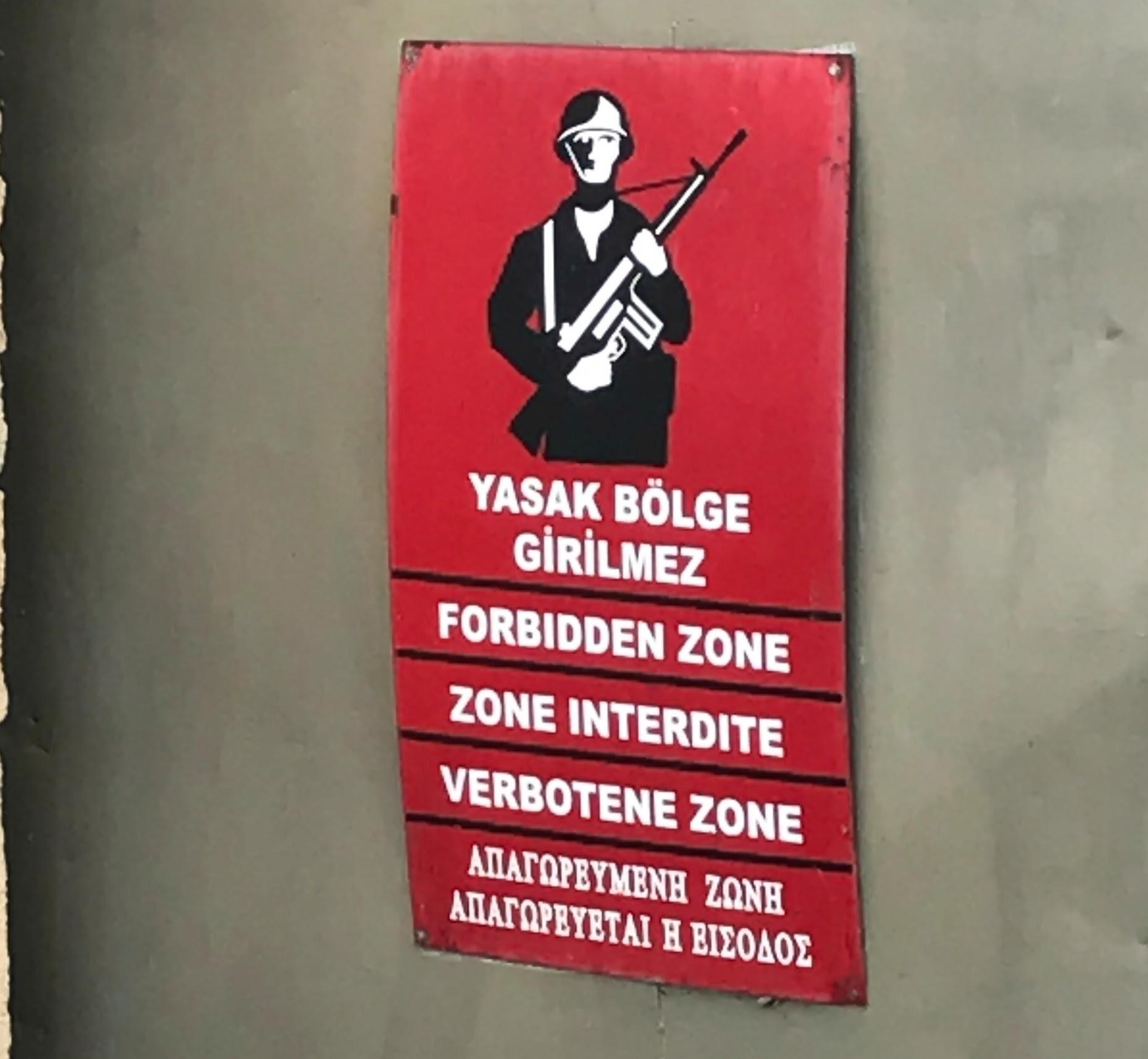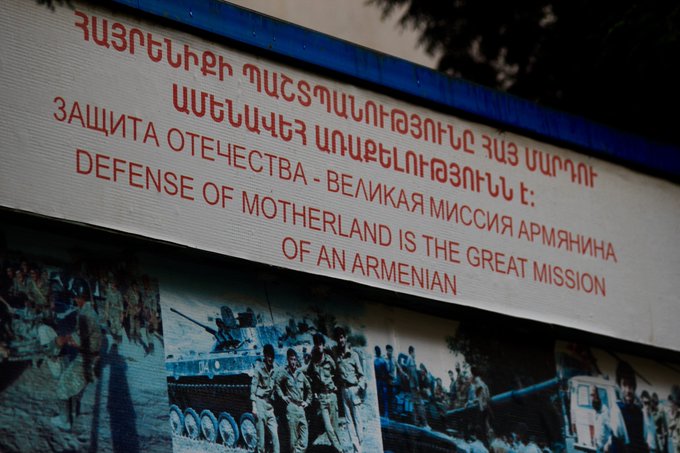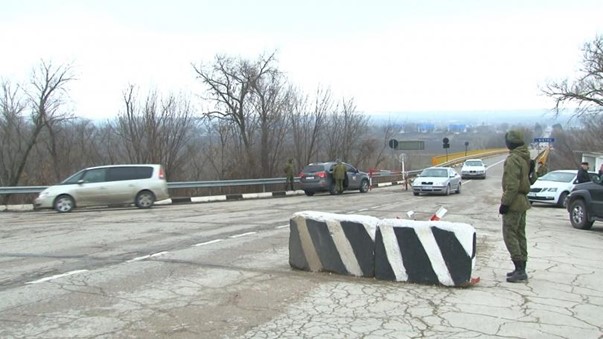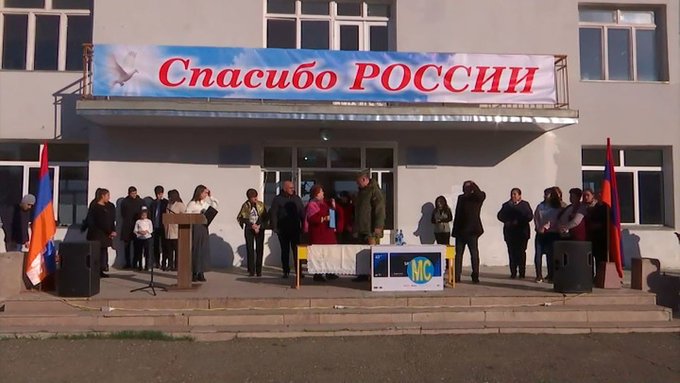Practical Field Research in Conflict Areas: Cyprus
Nicosia, the capital city of Cyprus, is an extremely pleasant and popular tourist destination. Walking along its many clean and vibrant streets, surrounded by passerby going about their daily lives in what must be one of the most sun-kissed cities in the world, imparts a wonderful sense of warmth and tranquillity. It is only when travelling down Ledra street, nearer to the heart of the city, that one would find the crowds of people thinning and the sounds of the daily hustle-and-bustle fading.
Nicosia is known as the “world’s last divided capital,” and near its centre border-crossing checkpoints stand. Once hopeful signifiers, gateways through a previously nigh-impenetrable gap between the two communities, their continued presence has become a monument to the separation between both Cypriot communities, a constant reminder of the uncertainty and tension that lingers in Cyprus today.
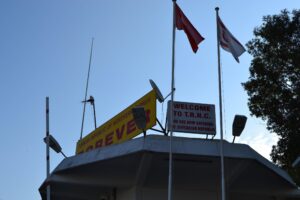
The Ledra Palace border-crossing checkpoint leading into Northern Cyprus. The slightly obfuscated sign on the left reads “Turkish Republic of Northern Cyprus Forever.” Photo Credit: Katie Clark.
On April 8th, 2018, eight students and I flew into Larnaca airport to meet the tenth student, who had flown into Cyprus through Ercan International Airport, and begin a one-week research trip in Cyprus, an integral part of our “Practical Field Research in Conflict Areas” course. Our semester up until that point had focused on the conflict between the two communities on the island, its further complication by external actors attempting to impose or negotiate solutions, and contemporary peace-building on the island. Equipped with that knowledge, guided by Professor Eiki Berg and PhD Fellow Maili Vilson, and hosted by Near East University, we prepared ourselves for an intensely educational week and experience.
Our education began even before we touched down on the island itself. Our entry via Larnaca airport placed us within the internationally recognized government on Cyprus, the Republic of Cyprus. The Republic of Cyprus, depending on which party is questioned, is either a single state established in 1960 and divided by a UN buffer zone intended to maintain peace despite an illegal occupation in 1974, or one of two states sharing Cyprus. The other state within that viewpoint is the Turkish Republic of Northern Cyprus, which was proclaimed in 1983 and is currently recognized (and heavily supported) only by Turkey.
As such, our journey from Larnaca airport to our accommodation at Near East University involved immediately crossing through one of the border crossing areas established along the dividing line between Northern and Southern Cyprus. We rejoined the final member of our group and made ourselves comfortable as we prepared to experience life in divided Cyprus.
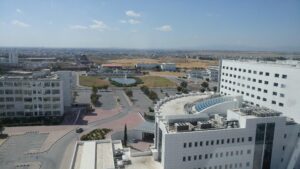
The view from our accommodations within the Near East University campus. Photo Credit: David Liggera.
An overview of the conflict
When exactly the conflict in Cyprus began is – like so many other political and historical matters on the island – dependent on who exactly you ask. The island’s legacy was forged from the administrations of the Ottoman Empire and the United Kingdom respectively, shaped by strong feelings toward (and from) Greece and the Ottoman Empire, and marked with domestic and colonially imposed communal segregation between Greek and Turkish Cypriots alike. This state of affairs led to the creation of a semi-sovereign “state of exception” in Cyprus; the creation of the Republic of Cyprus that nobody wanted in 1960 with the United Kingdom, Turkey, and Greece instated as guarantor powers, with the right to intervene in the politics of the island in exceptional circumstances.
Here, the stories diverge. The Turkish Cypriot community remembers that period as one defined not by political unity, but by political dominance from the Greek Cypriot community. This state of affairs led to Turkish Cypriot politicians and civil servants being forced out of their positions, Turkish Cypriot citizens being forced into enclaves to protect themselves, and finally, an outright attempt supported from Greece in 1974 to directly attack Turkish Cypriots and fully subjugate them. The subsequent intervention by Turkey and formal establishment of the TRNC was inevitable, due to the inability of Greek Cypriots to work with Turkish Cypriots and move away from ultimately unifying the Republic of Cyprus with Greece. Maintaining a state, despite lacking support from the international community, became the only realistic means to ensure the continued safety of Turkish Cypriots.
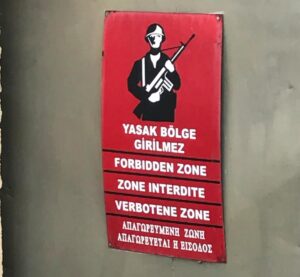
One of many signs posted throughout Northern Cyprus indicating the location of a military base and reminding tourists and other passers-by not to enter without explicit permission. Thousands of Turkish soldiers remain stationed in Northern Cyprus. Photo Credit: Ryan Bastek.
Among Greek Cypriots, the difficulties faced by Turkish Cypriots in the Republic of Cyprus government were not due to repression from the Greek Cypriots, but due to their boycotting and purposefully refusing to participate in the government. This refusal reflected the desire of the Turkish Cypriot community to partition the island of Cyprus and maintain a foothold for Turkey within it. The military junta assuming power in Greece and successfully launching a coup against the government of the Republic of Cyprus provided justification for Turkey to commit to a military intervention on the island and exploit the situation for their own benefit. The actions Turkey pursued against the Republic of Cyprus went beyond protecting Turkish Cypriot citizens, highlighting their desire to subjugate the people of the Republic of Cyprus by illegally maintaining a heavily militarized and illegitimate state.
Whichever story you believe, some aspects of life in Cyprus are indisputable. A demilitarized zone was established by the United Nations following an outbreak of violence between Greek and Turkish Cypriot communities in 1964. This “green line” became nearly impassable following the events of 1974 until border crossings were eased in 2003. Sovereign Base Areas are maintained by the British military on the island, and the United Kingdom retains its guarantor powers, as do Turkey and Greece. Massive resettlements of Turkish and Greek Cypriots, along with billions of euros worth of property taken during the Turkish intervention in 1974, remain particularly salient and incendiary legal conundrums. And despite a number of rounds of peace talks between Greek and Turkish Cypriots, the conflict (while peaceful) remains a constant part of life on the island, with consternation over maintaining the separation between the two communities or attempting to reunite Cyprus lingering in the minds of civilians and politicians alike.

Political graffiti emblazoned on a barrel near the UN Buffer Zone. Photo Credit: Ryan Bastek.
Northern Cyprus
Our field trip to the conflict region was to last only a week, so our introductory day was spent not only on getting acclimated to Northern Cyprus and the Near East University campus but on visiting Kyrenia, one of the most significant cities in Northern Cyprus. Bleary-eyed as we may have been from our arrival earlier that day, the sights and sounds of Kyrenia provided an amazing incentive for us to press on. As spectacular as the remains of Kyrenia castle and the enchanting shades of the Mediterranean sea were, I found myself drawn to some of the more unique aspects of life in Northern Cyprus.
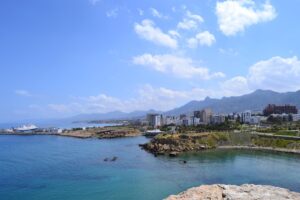
A small piece of the view from Kyrenia Castle. Photo Credit: Katie Clark.
Of particular interest were the numerous flags of Turkey and the Turkish Republic of Northern Cyprus visible throughout Kyrenia, always flown in tandem. They, accompanied by calls to prayer broadcast throughout Kyrenia (and other cities in Northern Cyprus) were constant reminders of the close relationship shared between Turkey and Northern Cyprus. They at once emphasized the identity cultivated within the Turkish Cypriot community and contributed to widening the divide between the Turkish and Greek Cypriot communities.
This was most strikingly spelled out by the representation of two incredibly large flags – a Turkish and a Turkish Republic of Northern Cyprus flag – drawn on the southern side of the Kyrenia Mountains in Northern Cyprus. They are large enough to be seen from the south as well, and on clear days, we could make out the slogan accompanying them: “Ne mutlu Türküm diyene!” (How happy is the one who calls himself/herself a Turk!) These flags strongly symbolize not only the identity of Northern Cyprus, but due to their prominent visibility, an ever-present reminder of its continued existence to residents in the Republic of Cyprus. Visibility clearly was emphasized in their creation, as when the sun sets, the flags light up to transmit the same message around the clock.
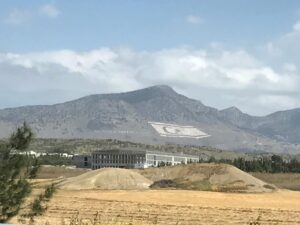
The flags on the Kyrenia Mountains during the day. Photo Credit: Ryan Bastek.
Most of our time spent in Northern Cyprus was utilized to garner local academic and political perspectives of the conflict. To that end, we attended a number of excellent seminars hosted by the faculty of Near Eastern University and learned more about differing frames of the conflict in Cyprus. These lessons ranged from the specific history of Cyprus in terms of political legacies imparted by the Ottoman empire (such as how the relationship between the British and Ottomans and its strain due to WW I led to the British annexation of Cyprus) to more contemporary political interactions between the two communities after 1974 (a common theme of the peace negotiations can be summed up effectively with the phrase “nothing is agreed until everything is agreed”), introducing a variety of perspectives and frames through which to analyze the conflict.
Perhaps the most fitting trip and discussion we had as a group was on the beaches of Northern Cyprus, near the former beach resort of Varosha. A once thriving tourist destination, Turkey had seized the property over the course of its military intervention and held onto it as a bargaining chip to entice cooperation from Southern Cyprus. The attempt seemed emblematic of the conflict itself: what had been perceived as a hopefully quick means of ensuring (at the very least) cooperation between the two sides had fallen apart. As “comfortable” as the conflict might be, with few incidents of violence and a relatively porous border separating the two communities, the pursuit of its ultimate resolution seemed truly onerous to academics and politicians in Northern Cyprus alike.
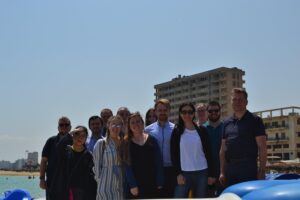
A group photo with Dilek Latif, featuring Varosha looming in the background. Photo Credit: Katie Clark.
The Buffer Zone and the Republic of Cyprus
An interesting incident occurred during our first crossing through the Ledra Street border-crossing checkpoints, from Northern Cyprus into Southern Cyprus. Entering the buffer zone itself and experiencing an almost eerie silence as we made our way across several meters of land that would have been inaccessible mere decades ago would have been enough of an experience, but crossing back over became one of the most exciting events on the trip itself. The student in our group who had entered Cyprus through Ercan airport was stopped shortly after initially getting approval from border-crossing guards, who were alarmed over his entrance through an unrecognized and illegitimate point of entry. His passport was graciously not held as a result, and he was allowed to reenter Northern Cyprus with the rest of us, but the incident remained a stark reminder both to the problems relating back to legitimacy on the island. Quite expectedly, he was not permitted to enter the Republic of Cyprus again for the duration of our stay in Cyprus.
Aside from that event, our group’s experiences in the south were enormously positive and educational. We once again entered on April 11th, and were immediately treated to a brief walk around the southern side of Nicosia, which, among other things, had some ambitious construction goals that did not quite mesh with reality. We were specifically shown the Eleftheria Square construction zone, but regardless of the problems encountered in its construction, the attempt to provide a new central hub within the divided capital is quite laudable.

Walking past some of the construction around Eleftheria Square. Photo Credit: David Liggera
We were graciously welcomed to the House of Representatives of the Republic of Cyprus, and allowed to meet with Chairman Yiorgos Lillikas of the Citizen’s Alliance, a political party within the coalition government. The ensuing discussion we had with him promoted a markedly different perspective than we had become accustomed to hearing, and reflected a different set of concerns regarding the future of Cyprus, emphasizing the difficulties with establishing trust and means of cooperation between the two communities. For some members of both Greek and Turkish Cypriot communities, the events of (and leading up to) the 1974 Turkish intervention were evidence of the other communities untrustworthiness and deleterious capabilities. The extent to which reconciling those concerns had to be addressed, one way or another, in moving forward with effective governance in Cyprus was expressed very honestly during our meeting, providing yet another frame for us to utilize in examining the Cyprus conflict.
A meeting with Professor Constantinou at the University of Cyprus following our time at the House of Representatives concluded our day’s work in the south. We had read one of his articles on conflicting discourses and practices regarding legitimation and recognition in Cyprus, and it was a fascinating and welcome experience to get to further understand his perspectives on the conflict and its history.
We travelled into the buffer zone from the Ledra Palace border crossing the following day and attended a presentation given by, and at, the “Home for Cooperation,” a non-governmental organization located within the UN buffer zone. The aim of the organization was to facilitate communication and dialogue between the two communities and provide a common place for members of both communities to mingle and attend events. Imagining what occurred in the large swath of land dividing the Cypriot communities was a subject of intrigue for me before I went to Cyprus. Far from being an empty space frequented only by the United Nations, visitors today would see what could potentially mark the transformation of the space from an empty space to a location where members of both communities could intermingle freely.
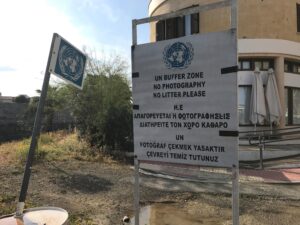
One of many signs within the UN Buffer Zone. Photo Credit: Ryan Bastek.
Our final experience within the buffer zone concluded with a trip to Pyla, a village within the buffer zone which quite notably was the only village for many years wherein Greek and Turkish Cypriots lived alongside one another. The village itself was enormously peaceful (as it hopefully would be, considering the constant presence and watchful eye of the United Nations), and while some of our original plans did not work out as well as we had hoped, we were still able to enjoy a relaxing meeting with the Turkish Cypriot Mukhtar (head of the village), and appreciate a moment within the buffer zone which, but for the presence of the United Nations, felt like it could have occurred in any small, peaceful town in Europe.
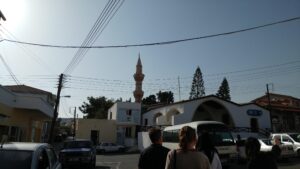
A pleasant view of Pyla, with the United Nations building directly behind me. They were not fond of tourists taking pictures of the building itself. Photo Credit: David Liggera
Conclusions
Our trip concluded with a return to Larnaca for the day, not to participate in any academic or political activities related to the conflict, but just to enjoy a day to unwind and process everything that we had experienced together during the trip. The journey home gave me some time to pause and reflect on my experiences in particular, and the blog post you have just finished reading through is largely based on the notes I took as we waited for our plane back to Estonia to arrive.
The time we spent in Cyprus working and learning together as a class was a truly educational and unforgettable experience. One of the fallacies of studying conflicts and immediately finding conclusions stems from a lack of connection to the people experiencing the conflict, whose families and lives were, and continue to be, impacted by its perpetuation. Our trip to Cyprus provided that connection to the people involved and their experiences, and reminded us all of the importance of understanding multiple perspectives and experiences to better help provide stable solutions for a peaceful future.
This trip and the knowledge we gained, as a result, would not have been possible without the amazing work and dedication from Dilek Latif, Sait Aksit and all of the staff and friends we met and worked with at Near East University. I believe I can honestly speak for all of us from the University of Tartu when I say that the lessons you taught us and the experiences we shared together will always be in our hearts. I would also like to thank Professor Eiki Berg and PhD Fellow Maili Vilson for establishing this course and trip to Cyprus. The work both of you do is always an inspiration to me, and I am proud to be learning from both of you as a student at the University of Tartu.
Finally, I would like to thank my ever-inspiring classmates and friends who accompanied me on this study trip, took many of the pictures used within this blog post, and help me learn more about the world and myself every day: Artur Tänna, Elina Libek, Katie Clark, Thomas Rosenbloom, Xiaohan Ma, Ryan Bastek, Rusif Huseynov, Taavi Linnus, and Patrīcija Saltupe.
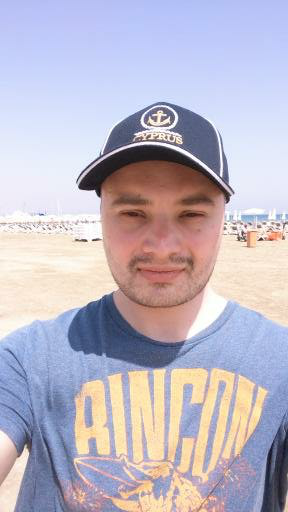
David Liggera, the author of the blog post, on the beach in Larnaca. Photo Credit: David Liggera
David Liggera is a first-year student in the International Relations and Regional Studies Program at the Johan Skytte Institute of Political Studies.


